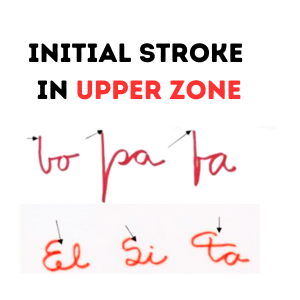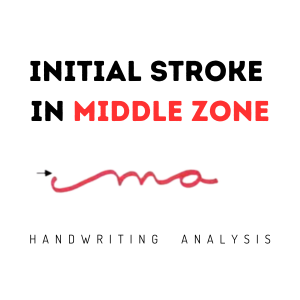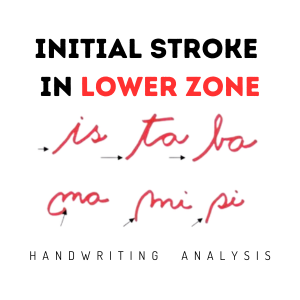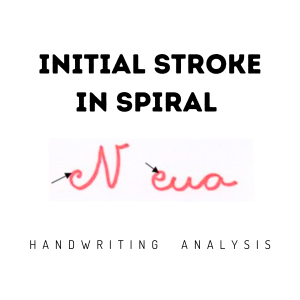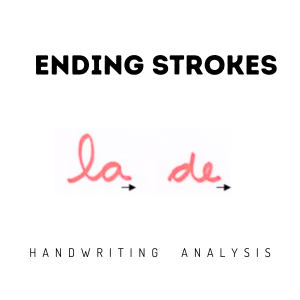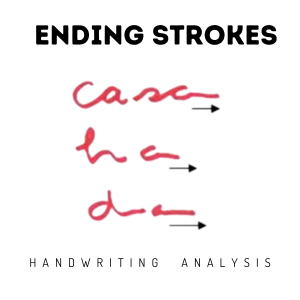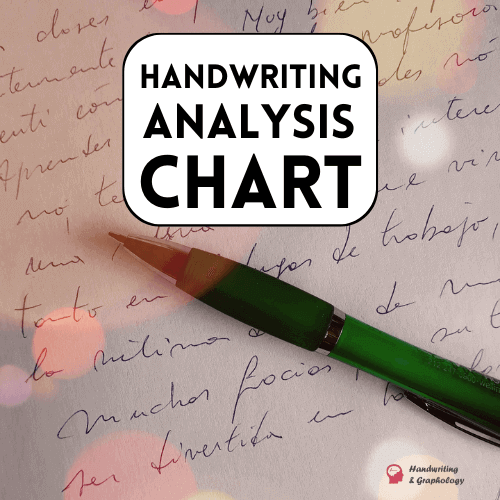Initial Strokes in Handwriting
Hello friends! The initial and final strokes in graphology refer to the first and last movement we make when forming each of the letters. As always, I emphasize that in order to achieve a correct interpretation, the traits should never be analyzed in isolation. The entire context of the writing must be considered, and whether there is a predominance of letter shapes or movements should be observed.
Psychological interpretation of Starting and Ending Strokes
The initial and final strokes in graphology represent how an individual begins and ends an action.
The initial stroke that appears at the beginning of each graphic sign can be letters, numbers, or symbols (+, *, #, $, 1, /). It symbolizes how one connects with the surrounding environment, how the action begins, the origin of the impulse, and the intentions in motion. It reflects a person’s attitude towards their desires and needs. It is linked to memories, experiences, and emotional experiences from the past.
Initial and ending strokes according to Zone and Shape
For their interpretation, the symbolism of Max Pulver’s graphic space is applied. According to the zone of writing where the stroke begins: upper, middle, and lower zone. The shape that the stroke takes is also considered: angle or curve. In all cases, a constant must result, as isolated strokes are not taken into account.
- When the impulse begins in the upper zone, upon connecting with the surrounding environment, it draws inspiration from intellect or spirituality.
- On the other hand, when the initial strokes start from the middle zone, it signifies being driven by emotional needs. The person moves through life seeking contact with others, inspired by their emotions, sentimental experiences, and daily needs.
- The impulse that starts from the lower zone of the writing indicates material and instinctive tendencies that can be more or less passionate or violent, depending on whether curves or angles predominate.
Shape
• Predominance of curves: Curves give the initial strokes the magic of adaptability, smoothness, joy, and cordiality.
• Predominance of angles: If they are straight and end in an angle, it means that desires go directly to their goal regardless of the situation or conditions, without adapting and inflexibly.
• Long and curved initial stroke: Ability to achieve goals and satisfy one’s own tastes.
• Diagonal: It is a sign of social maladjustment. The person becomes blinded by anger in the face of frustrations, argues, attacks, and gets offended. The more rigid and violent the movement, the more combative the individual.
• With a harpoon: If accompanied by diagonal strokes, the person’s attitude is reinforced by obstinacy, tenacity, and intransigence. If the subsequent movement is curved, it means they can yield to a gentle suggestion.
• Spiral: The spiral is an egocentric, narcissistic gesture that revolves around oneself. The person believes that situations are only as they see them and becomes pleasant only in order to achieve what they want. The initial stroke is of less importance because it moves away from the center of the self. However, in the final strokes, the interpretation is more pronounced as they “coil” further within themselves.
• Initial stroke with a loop: Ability to conquer the environment and obtain approval and satisfaction.
• Horizontal: Indicates stubborn effort to reach goals regardless of the resistance encountered within or outside oneself.
• Arched: Reflects a desire to appear. Klages speaks of “distinguished manners and chosen ways.” It shows pride and superiority.
• Short: Symbolizes liberation from the Narcissistic complex and little concern for one’s own self. The person identifies their existence in others, in their profession.
• Direct: Corresponds to simplified writing. It gets to the heart of the matter, does not dwell on trivialities, has the ability to synthesize, and is concise and decisive.
Initial traits according to Pressure
• Weak: The pen lightly touches the paper. This initial “delicacy” symbolizes indecision due to shyness or fear when starting new actions.
• Good pressure: In this case, there is pressure at the beginning of the stroke. It symbolizes initiating situations with energy, confidence, and firmness.
Different ending strokes
The direction of the final stroke represents the future. If the subject goes “towards others” or “against”. It also indicates the need for space.
• Clear: The final strokes of the letters are executed correctly. They express reliability. It means that matters are concluded responsibly, especially when they are the final strokes of letters in the name and surname of a signature.
• Confused: These are poorly executed strokes, characteristic of good negotiators and individuals who do not commit fully. They seek to take maximum advantage of situations while leaving matters unclear, indicating mistrust and unreliability.
• Ascending: Upward strokes have a dual interpretation. Therefore, it is important to see the rest of the text. It symbolizes optimism and efforts to overcome adversity, but it can also lead to rebellion and resistance to authority.
• Descending: Tendency toward discouragement and depression.
• Contained: It is interpreted as difficulties in connecting with the environment, inhibitions. The more the final line is contained, the more accentuated is prudence, reserve, shyness, and control of impulses when making contact with others. To such an extent that he can annul himself in the face of realities and other people.
• Projected: Sudden movement at the end. It means that the person cannot control themselves. They try to control their response but “explode.”
• Mass: It becomes thicker and thicker.
• Point: Unlike the previous type, its thickness decreases.
The long endings associated with large, extensive and very sloping writing indicate an uncontrollable need to talk, talkativeness, indiscretion.
Ends prolonged downwards: If the line is straight and firm, it expresses a determined attitude or a specific desire. If the line is heavy or pasty, it may indicate materialism or low mood.
This concludes the article about initial and final strokes in graphology. Keep browsing this website to learn more about graphological gesture types.


